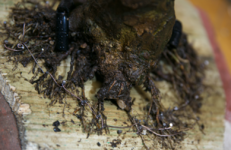Yeah that annual lifting of the tree from the pot would be sort of a hassle. I hear ya

The worst part would be trying to arrange the roots out radially, and tacking them with little nails, working from above. Remember, the tree will have a canopy, which will be in the way! It‘s difficult enough just doing it on a board! (I’ve done it.)
And, you’ve also lost the advantage of allowing roots to get to the edge of the board, and grow down to a lower level of soil. This really aids in thickening. Have you ever noticed how “circling roots” stay thin? They’ll get long, but they don’t really thicken. Downward growing roots, on the other hand, tend to thicken.
A tree in nature, not in a pot, uses roots to anchor it’s place in the soil, and also to absorb water and nutrients. It need thick, strong roots to do that anchoring. In a bonsai pot, we use wire to anchor the tree in place, so the tree doesn’t need anchor roots. A large part of bonsai culture is encouraging small feeder roots, right? But, if we want to create the dinner plate nebari, and do it quickly, we want “thick roots”. The trick is to do it in a controlled manner. Screwing on a board is the best method devised, so far. Even if the goal is to just have a nice, spreading nebari, the board method works. Just don’t do it for a long of a time.
Even using a board, to create the dinner plate nebari takes a long time.










